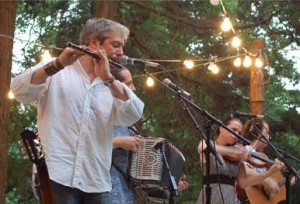Previews of the new Solas CD, “For Love and Laughter,” have been up on the band’s Web site for many weeks. The clips are short, but tantalizing. There’s just enough there to make it clear that Solas—with the band’s new singer Máiréad Phelan—is evolving.
The clips are just a half a minute long—the merest tease. So you were left to wonder just how much Solas might change following the departure of singer Deirdre Scanlan.
Whatever were you fretting about?
Solas is still Solas—the band’s trademark sound fully intact—and all’s right with the world. With the new singer and some intriguing collaborations, including cellist Natalie Haas, world music artists The Duhks and the Appalachian multi-instrumentalist Dirk Powell—they might even be better. And of course, no Solas performance would be complete without longtime bassist Chico Huff.
The opening set—“Eoin Bear’s Reel,” “Tune for Sharon” and “The Rossa Reel”—could settle comfortably into any Solas CD to date. With leader and all-Ireland multi-instrumentalist Seamus Egan setting the pace, the rest of this gifted band—the fiddler Winifred Horan, button accordionist Mick McAuley and guitarist Éamon McElholm—merrily bend tradition to their will. The first sound you hear is a sly little smile of a note from Horan’s fiddle. The two tunes that follow are tightly controlled—but just barely—with Horan’s fiddle and McCauley’s accordion playfully crossing paths, occasionally overlapping, then spinning off in opposite directions. This is Irish music as Jezzball. Egan and McElholm close out the set with a strong, percussive “Rossa Reel.”
(In fact, the whole album is percussive. Perhaps because it was recorded and mixed by Solas associate and drummer John Anthony, who plays on several tracks, “For Love and Laughter” seems like the most percussive Solas recording since 1997’s “Sunny Spells and Scattered Showers.”)
A later set—the improbably named “Vital Mental Medicine” paired with “The Pullet”—cinches the deal. The first is a scary Rubik’s Cube of rhythms and counter-rhythms, Egan leading the way on banjo. The whole “Mental Medicine” gives way to a furious interpretation of “The Pullet.” If you’ve ever seen Horan play, you know that she does cruel things to bowstrings. It’s a pretty good bet she shredded a few on this number.
That’s the Solas we know. But what about the new singer?
Máiréad Phelan gets a chance to earn her pay early on. She is front and center on the second track, “Seven Curses,” and she more than holds her own.
It’s clear from the start that Phelan does represent something of a departure. Her voice is softer and breathier than Scanlan’s. And she’s not a belter like the diminutive Karan Casey, Solas’s first vocalist. Think Heidi Talbot or Pauline Scanlon. That’s closer to the mark.
Phelan’s voice stands out on its own, but she is often supported by harmonies from McAuley and McElholm.
The material is generally very well matched to her talents, perhaps especially the haunting traditional long song, “Molly na gCuach Ni Chuillean.” It sounds like a tune she was born to sing. Once again, McAuley and McElholm join in on harmonies. Natalie Haas also makes her first of three appearances. (A later pairing with Horan on the instrumental “My Dream of You” is dreamlike and nothing short of inspired.)
Probably the best overall vocal performance features Phelan with accompaniment by The Duhks on the bluegrass-flavored “Merry Go Round,” written by frequent Solas contributor Antje Duvekot. If there is one number destined to become the perennial crowd-pleaser, this one probably is it.
McAuley’s vocal talents also are showcased on the tune’s title track, with superb harmonies from McElholm and Phelan. During the brief period in which the band was without a lead singer, McAuley and McElholm (who also plays piano and Hammond organ on some tracks) stepped into the breach. It’d be nice to hear more from them.
At the heart of it all, of course, is Seamus Egan, who plays no fewer than nine instruments on this album—crushingly depressing to those of us who play only one, and not as well. Certainly not to discount the contributions of others—notably, the wonderful Winifred Horan—Egan pretty clearly remains the soul of Solas. So long as that is the case, the band can weather personnel changes, as it has many times in its 13 years.
You can see and hear the proof for yourself September 21 at 7:30 at World Café Live.
You’ll also be able to hear the whole album—and not just our few clips—when “Love and Laughter” goes on sale August 26.

